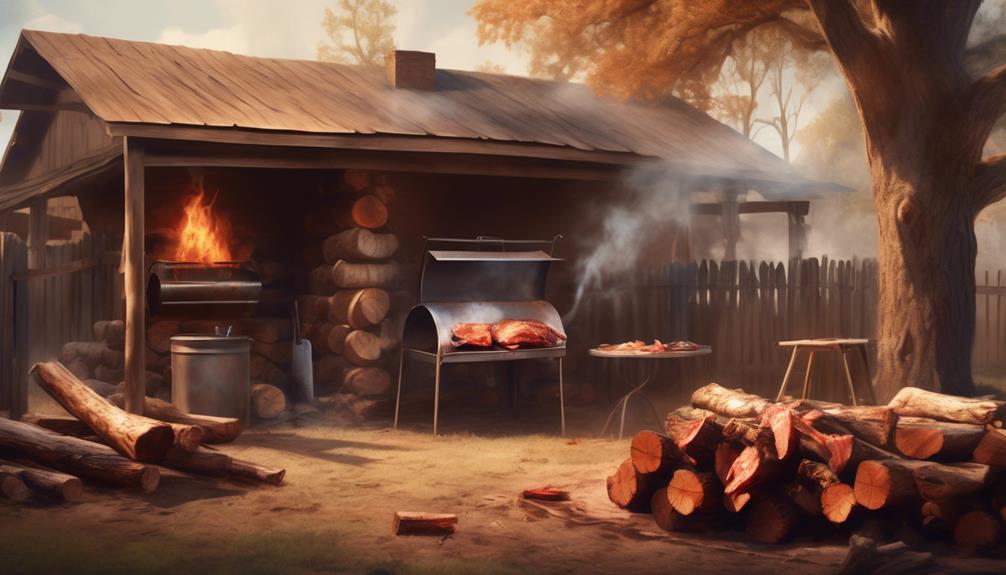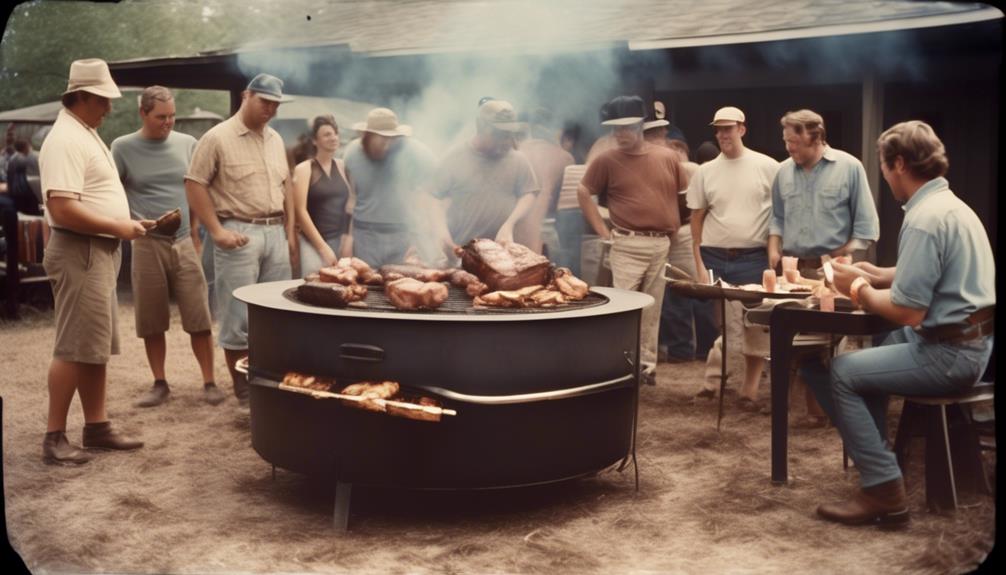Barbecue traditions have long been a celebrated culinary art form, each region and country contributing its own unique techniques and flavors to the tradition. From the open fire grilling method of South Africa’s Braai to the diverse styles found across East and Southeast Asia, and the varied barbecue practices in Europe and the Americas, the world of barbecue is as diverse as it is flavorful.
Table of Contents
As we explore the techniques and regional variations of barbecue traditions, we will uncover the rich history, unique methods, and distinct flavors that make this culinary tradition a fascinating topic to explore further.
Key Takeaways
- Barbecue techniques and traditions vary greatly across different regions, showcasing the diverse culinary landscape of the world.
- Each region has its own unique flavor profiles and ingredients, influenced by cultural heritage and local ingredients.
- Grilling and smoking are distinct techniques in barbecue, each offering its own set of characteristics and health benefits.
- Regional barbecue styles and specialties, such as Kansas City’s sweet and tangy sauces or Hawaiian barbecue variations, highlight the fusion of culinary influences and indigenous ingredients.
Barbecue Techniques in Zimbabwe

Zimbabwean barbecue techniques, characterized by outdoor grilling over open flames or hot coals, often involve marinating the meat with a blend of spices, herbs, and vinegar to create a rich and flavorful culinary experience. This method of marinating, known for its ability to tenderize and infuse the meat with bold flavors, is a hallmark of Zimbabwean barbecue. The marinade typically consists of a mixture of indigenous spices and herbs, reflecting the diverse and vibrant culinary culture of the region.
The outdoor grilling culture in Zimbabwe is deeply rooted in communal gatherings and celebrations. It serves as a focal point for social interaction, bringing families and friends together. It is not only about the food but also the shared experience and camaraderie that make Zimbabwean barbecue a cherished tradition. The choice of meats, such as beef, chicken, and goat, highlights the country’s agricultural heritage and the significance of livestock in Zimbabwean cuisine.
Furthermore, traditional Zimbabwean barbecue often incorporates local ingredients and flavors, adding a unique twist to the grilling process. This infusion of indigenous elements enhances the authenticity and regional identity of Zimbabwean barbecue, making it a culturally enriching culinary practice.
East Asian Barbecue Traditions
East Asian barbecue traditions encompass a wide range of grilling techniques and flavor profiles. From Chinese chuanr to Korean bulgogi and Japanese yakitori, each region offers its own unique take on barbecue.
These traditions highlight the diversity and complexity of East Asian cuisine, showcasing the rich culinary heritage of the region.
Asian Grilling Techniques
The diverse East Asian grilling techniques encompass a wide range of culinary traditions and cooking methods, showcasing the rich and varied flavors of the region.
When compared to other regions, East Asian grilling methods stand out for their unique approach to cooking over open flames, such as chuàn from China and Korean barbecue. These techniques often involve marinating meats in soy sauce, sesame oil, and other flavorful ingredients.
Additionally, Asian grilling techniques make use of unique ingredients like marmots, goats, and even heated stones for cooking.
Furthermore, the emphasis on seafood and vegetables in Japanese barbecue sets it apart from other global grilling traditions.
These distinct grilling methods contribute to the exceptional and diverse culinary landscape of East Asia.
Regional Flavor Profiles
Exploring the regional flavor profiles of East Asian barbecue traditions reveals the distinctive culinary signatures that distinguish grilling techniques across China, Hong Kong, Macau, Korea, Japan, and Mongolia.
Each region’s barbecue traditions are heavily influenced by cultural factors, resulting in a diverse array of flavors and cooking styles.
Regional spice blends play a crucial role in defining the taste of East Asian barbecue. In China, Hong Kong, and Macau, the use of five-spice powder and soy-based marinades imparts a unique flavor to the grilled meats.
Meanwhile, Korea’s barbecue is characterized by the use of gochujang-based marinades and sesame oil, resulting in a perfect blend of sweet, savory, and spicy flavors.
In Japan, the emphasis on fresh, high-quality ingredients and delicate seasoning showcases the country’s culinary refinement.
Moreover, Mongolian barbecue dishes are influenced by the region’s nomadic heritage, featuring a focus on hearty meats and simple, yet flavorful, seasoning.
Southeast Asian BBQ Variations

In the diverse culinary landscape of Southeast Asia, barbecue traditions encompass a rich tapestry of unique dishes and cooking techniques, reflecting the vibrant flavors and cultural heritage of the region.
When exploring Southeast Asian BBQ variations, one encounters a delightful array of flavors and cooking styles, including:
- Filipino BBQ dishes: The Filipino barbecue tradition features an assortment of delectable dishes such as Inihaw, a local favorite made with pork or chicken, and Lechon, a whole pork skewer stuffed with lemongrass and spices.
- Satay variations: Satay, a beloved Southeast Asian dish, offers a variety of skewered meats marinated in a blend of spices and ground peanuts. This versatile dish is commonly prepared with chicken, lamb, beef, or pork, showcasing the diverse culinary influences of the region.
- Singaporean BBQ: In Singapore, barbecue gatherings are a common social affair, often featuring charcoal-grilled Southeast Asian and Western dishes. Many choose to rent barbecue pits in popular parks for these gatherings, adding a communal element to the experience.
- Thai Barbecue: Thai barbecue traditions include the popular Moo Krata, a grilled sliced meat dish cooked in broth over burning charcoal. This dish offers an assortment of meats, seafood, and vegetables, showcasing the vibrant and diverse culinary heritage of Thailand.
European Barbecue Techniques
European Barbecue Techniques encompass a diverse range of grilling methods, from open grilling to smoking.
The Mediterranean influences the traditional spit-roasting method, often using herbs and olive oil to flavor lamb and pork.
Additionally, Scandinavia is known for its smoking techniques, particularly with fish such as salmon and herring.
Grilling Vs Smoking
Barbecue traditions in Europe encompass a diverse array of grilling and smoking techniques, each with its own distinct characteristics and regional nuances. When it comes to grilling vs smoking, European barbecue techniques offer a variety of options for enthusiasts to explore. Here’s a closer look:
- Grilling Techniques: European grilling often involves the use of charcoal or wood-fired grills, which impart a distinct smoky flavor to the food.
- Health Benefits: Grilling is known for being a healthier cooking method as it allows excess fat to drip off the meat, resulting in lower fat content.
- Smoking Techniques: The Mediterranean and Russia are known for their smoking techniques, which utilize wood chips or chunks to infuse meats with rich, smoky flavors.
- Regional Variations: European barbecue techniques showcase a range of regional variations and ingredient choices, offering a diverse and vibrant barbecue culture.
Mediterranean Flavor Influences
Grilling and smoking techniques in Europe give way to the rich and aromatic Mediterranean flavor influences in traditional barbecue practices.
Mediterranean grilling techniques are characterized by the prominent use of olive oil, garlic, and fragrant herbs such as rosemary and oregano, imparting a distinctive taste to the dishes.
Popular Mediterranean barbecue recipes often feature grilled seafood, marinated lamb, and skewered meats, showcasing the region’s culinary expertise.
Additionally, Mediterranean-style barbecues frequently incorporate a variety of grilled vegetables like eggplant, zucchini, and bell peppers, adding depth and variety to the meal.
Traditional Mediterranean dips and spreads, such as tzatziki and hummus, further complement and enhance the flavors of the grilled dishes, offering a well-rounded and flavorful dining experience.
These elements combine to create a unique and vibrant Mediterranean barbecue tradition, reflecting the cultural and culinary diversity of the region.
Barbecue Traditions in North America

What unique regional variations and techniques characterize the tradition of barbecue in North America?
North American barbecue history is rich and diverse, influenced by a variety of factors such as Indigenous cooking techniques and early Western European settlers. Here are some key aspects that define the barbecue traditions in North America:
- Regional Diversity:
North American barbecue showcases a wide range of regional variations, with dominant BBQ regions including Kansas City, Carolina, Memphis, and Texas, each with its unique techniques, rubs, and sauces.
- Cooking Methods:
North American pitmasters often utilize roasting or smoking foods over wood or charcoal at low temperatures for extended periods, resulting in tender and flavorful meats.
- Indigenous Influences:
Native American cooking techniques and ingredients have significantly influenced North American barbecue traditions, contributing to the diversity of flavors and cooking methods.
- Specific Regional Styles:
North American barbecue is characterized by specific regional styles such as Kansas City-style BBQ, Memphis-style BBQ, Carolina-style BBQ, and Texas BBQ, each with its own distinct flavor profiles and cooking methods.
These factors collectively contribute to the rich tapestry of barbecue traditions in North America, reflecting a blend of historical, cultural, and geographical influences.
South American BBQ Practices
South American barbecue practices, unlike North American barbecue traditions with their regional diversity and specific styles, are centered around the traditional social cooking event known as ‘asado’. This cultural tradition brings together friends and family to enjoy the art of grilling meats over an open fire, often using wood or charcoal as fuel. Asado typically features a variety of meats such as beef, pork, and chicken, with a particular emphasis on cuts like chorizo, morcilla, and various steaks.
One of the defining characteristics of South American barbecue is the use of chimichurri, a zesty herb and vinegar-based sauce, as a key condiment. In Brazil, grilling techniques vary from region to region, with different methods for preparing and seasoning meats. Additionally, South American barbecue competitions showcase the skill and expertise of grillmasters, who demonstrate their mastery of traditional asado techniques and flavors.
South American barbecue is not simply a method of cooking; it is a cultural practice that celebrates community, tradition, and the art of grilling.
Oceanic Barbecue Customs

Oceanic barbecue customs encompass a diverse range of grilling practices and culinary traditions from South African braais to East Asian chuàn and Southeast Asian satay dishes. This rich tapestry of barbecue customs includes:
- South African Braai Traditions: The braai is a social cooking practice in South Africa, bringing together people from different ethnic backgrounds to grill meat using various types of fuel such as wood, charcoal, briquettes, and gas.
- East Asian Grilling Methods: East Asian barbecue customs feature chuàn in China, chashu in Hong Kong, and bulgogi in Korea, with a focus on marinated meats grilled over charcoal or at the table.
- Southeast Asian Variations: Southeast Asian variations include Mongolian barbecue dishes like holhog and boodog, as well as popular satay dishes in Thailand, Malaysia, Singapore, Indonesia, and the Philippines.
- Filipino Barbecue Techniques and Unique Grilling Methods in the Alps: Oceanic barbecue customs also include Filipino barbecue, with dishes like inihau and lechon, as well as unique barbecue practices in regions like the Alps and Germany.
These traditions demonstrate the diverse and vibrant nature of Oceanic barbecue customs, showcasing a wide array of grilling techniques and flavors that reflect the rich cultural tapestry of the region.
Barbecue Styles in the United States
How do the barbecue styles in the United States reflect the diverse culinary traditions and regional variations across the country?
Barbecue traditions in the southern United States have given rise to a rich tapestry of regional barbecue styles, each with its unique flavors, techniques, and cultural influences. Kansas City, Carolina, Memphis, and Texas represent the bedrock of American BBQ, with each region offering distinct characteristics.
Kansas City’s sweet and tangy sauces, Carolina’s slow-roasted whole hog barbecue, Memphis’s focus on pork ribs, and Texas’s emphasis on brisket and beef ribs showcase the depth of barbecue diversity within the United States.
Moreover, the fusion of barbecue styles has further enriched the American BBQ landscape. Alabama’s white barbecue sauce served with poultry, St. Louis’s fattier spare ribs, Santa Maria’s wood-fired tri-tip steaks, and Kentucky’s barbecued mutton and Burgoo stew exemplify the fusion of different culinary influences.
This amalgamation of traditions not only reflects the historical and cultural diversity of the United States but also demonstrates the adaptability and innovation within the realm of barbecue. The wide array of regional variations and fusion barbecue styles signifies the dynamic nature of American barbecue and its ability to evolve while remaining deeply rooted in tradition.
-What Are Some Regional Variations in Barbecue Techniques?
Different regions have their own unique basic barbecue cooking techniques. For example, in Texas, they use a dry rub and cook over indirect heat, while in the Carolinas, they prefer a vinegar-based sauce and slow-cook the meat over wood. Each area has its own twist on traditional barbecue methods.
Regional Barbecue Variations in Oceania

The rich tapestry of regional barbecue styles in the United States gives way to a new exploration of indigenous cooking methods and ingredients as we turn our focus to the regional barbecue variations in Oceania.
- Hawaiian barbecue variations:
Traditional Hawaiian barbecue features the Kalua pig, slow-cooked in an underground oven called an imu. It is often accompanied by poi, a Hawaiian staple made from taro, and lomilomi salmon, a dish featuring salted salmon, tomatoes, and onions.
- Maori hangi in New Zealand:
New Zealand’s Maori hangi involves cooking meat and vegetables in an earth oven using heated rocks, resulting in a unique smoky flavor and tender texture.
- Australian barbecue (barbie):
Australian barbecues, known as ‘barbies,’ often include classic cuts of meat like sausages and lamb, as well as seafood like prawns and snags. Indigenous Australian barbecues may also feature kangaroo and emu, reflecting traditional hunting practices and culinary heritage.
- Pacific Island barbecue traditions:
Pacific Island barbecue traditions emphasize fresh seafood, coconut, taro, and breadfruit, often prepared in an earth oven or over an open flame, showcasing the diverse flavors of the region.
Frequently Asked Questions
What Are the 4 Regional Styles of Bbq?
The four regional styles of BBQ include Carolina vinegar-based sauce, Texas brisket with dry rub, Memphis pork ribs with tangy sauce, and Kansas City sweet seasoning with thick sauce. These distinct styles showcase the diverse flavors of American BBQ.
What Are BBQ Techniques?
Smoking meats is a fundamental technique in barbecue, infusing them with rich, smoky flavor profiles. Pitmasters adeptly control temperature and smoke to achieve tender, flavorful results. Understanding these techniques is crucial for mastering the art of barbecue.
What Are the Techniques of Grilling?
Grilling techniques encompass direct and indirect grilling methods, utilizing gas, charcoal, wood, or electric heat sources. These techniques, when paired with marinades or rubs, create distinct flavor profiles and charred textures on food, enhancing the overall grilling experience.
What Culture Is Barbecue From?
Barbecue has deep historical significance in American and African cultures, with its origins dating back centuries. This cultural tradition has evolved to include diverse techniques and regional variations, reflecting the rich culinary heritage of both continents.
Conclusion
In conclusion, the diverse barbecue traditions around the world highlight the unique techniques and flavors that have developed in different regions and countries.
From the Braai method in South Africa to the various styles in East Asia, Europe, North America, South America, and Oceania, each barbecue tradition reflects the cultural and culinary heritage of the people.
The wide range of techniques and regional variations demonstrates the rich tapestry of barbecue practices across the globe.










